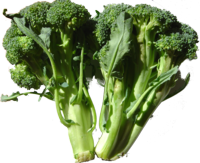Broccoli

Broccoli possesses abundant fleshy green flower heads arranged in a tree-like fashion on branches sprouting from a thick, edible stalk. The large mass of flower heads is surrounded by leaves. Broccoli most closely resembles its close relative cauliflower, but is green rather than white.
Broccoli is a cool-weather crop that does poorly in hot summer weather. It is usually boiled or steamed, but may be eaten raw and has become popular as a raw vegetable in hors-d'oeuvre trays. Broccoli is high in vitamin C and soluble fiber.
The word broccoli comes from the Latin brachium and Italian brocco meaning 'arm', or 'branch'. Broccoli is often referred to as a "cruciferous" vegetable. The Brassicaceae family (also known as the mustard or cabbage family) was formerly called the Cruciferae family, due to the fact that these plants often have four petals which can look like crosses.
Broccoli history Test-plot-grown broccoli near Salinas, California, USA. Roman references to a cabbage family vegetable that may have been broccoli are less than perfectly clear: the Roman natural history writer, Pliny the Elder, wrote about a vegetable which might have been broccoli. Some vegetable scholars recognize broccoli in the cookbook of Apicius.
Broccoli was certainly an Italian vegetable, as its name suggests, long before it was eaten elsewhere. Its first mention in France is in 1560, but in 1724 broccoli was still so unfamiliar in England that Philip Miller's Gardener's Dictionary (1724 edition) referred to it as a stranger in England and explained it as "sprout colli-flower" or "Italian asparagus". In the American colonies, Thomas Jefferson an experimentative gardener with a wide circle of European correspondents, from whom he got packets of seeds for rare vegetables such as tomatoes, noted the planting of broccoli at Monticello along with radishes, lettuce, and cauliflower on May 27, 1767. Nevertheless, broccoli remained an exotic in American gardens. In 1775, John Randolph, in A Treatise on Gardening by a Citizen of Virginia, felt he had to explain about broccoli: "The stems will eat like Asparagus, and the heads like Cauliflower."
Broccoli was naturalized by the D'Arrigo brothers, Stephano and Andrea, immigrants from Messina, Italy, whose company made some tentative plantings in San Jose, California in 1922, and shipped a few crates to Boston, where there was a thriving Italian immigrant culture in the North End, ready for a familiar green. The broccoli business boomed, with the d'Arrigo's brand name 'Andy Boy' named after Stephano's two-year-old son, Andrew, and backed with advertisements on the radio. So broccoli arrived in the U.S. in the 1920s as a 'new vegetable'. Broccoli and cauliflower have been recently crossed to create a vegetable called broccoflower, with very pale green heads densely packed like cauliflower, but with the flavour of broccoli.
Health Benefits of Broccoli
See: Science behind broccoli sprouts health benefits